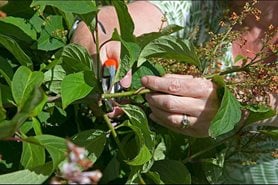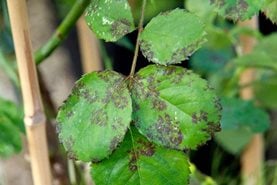Pruning and training
 This time of year is nesting season so always check for signs of activity before getting out the pruners. The Wildlife and Countryside Act 1981 protects bird nests so it is an offence to damage or destroy them.
This time of year is nesting season so always check for signs of activity before getting out the pruners. The Wildlife and Countryside Act 1981 protects bird nests so it is an offence to damage or destroy them.
Smaller shrubs are less likely to hide a nest but be especially cautious if tackling dense or mature shrubs and trees. Only start work once you are happy you will not be disturbing wildlife and stop immediately if you have any suspicion birds may be nesting. If need be, you can complete the work after August when nesting season should be over.
Cut back tender shrubs and sub-shrubs such as Penstemon, Caryopteris and Fuchsia after the danger of frost has passed.
Clip evergreen hedges. If not too woody, shredded clippings can be added to the compost heap, ideally in combination with soft material such as grass clippings.
Prune spring-flowering shrubs such as japonica or Japanese quince (Chaenomeles), Choisya and Ribes after flowering. Remove one stem in three from Kerria and Spiraea ‘Arguta’, and shorten the other flowered stems to a suitable sideshoot. Evergreens such as Viburnum tinus can also still be trimmed this month.
Prune overcrowded, dead or diseased stems of Clematis montana once it has finished flowering. Untangling the stems can be fiddly, but once you can see where you are cutting, you need not worry about pruning this plant - it will take even hard cutting back very well.
Prune out frost damage from affected evergreen shrubs.
Young mimosa trees (Acacia dealbata) can also be cut back now. Mature trees respond less well to pruning.
Remove any reverted green shoots on hardy variegated evergreens, to prevent reversion taking over.
Prune wall-trained pyracanthas, removing any shoots coming out from the wall, and shortening other new growth to about 8cm (3in). This encourages spur formation, and increased flowering relative to green growth.
Tie in climbing and rambling roses as near to horizontal as possible. This will restrict sap flow causing more side-shoots to grow along the length of stem. Therefore more flowers will be produced.
Twining climbers (such as honeysuckle and Clematis) need regular tying in and twining around their supports.
General maintenance
Ensure newly planted trees and shrubs do not dry out. Water with rainwater or recycled water wherever possible.
Loosen any tree ties that are digging into the bark, or could do so soon as the trunk girth expands.
Propagation
Take softwood cuttings of deciduous shrubs, including Forsythia, Fuchsia, Hydrangea macrophylla, Philadelphus and Spiraea.
Layering is a good way to propagate climbers and lax-stemmed shrubs. Layers should root by next spring, especially if attention to watering is given during dry weather. Examples to try include Philadelphus, Forsythia, Hydrangea and Lonicera.
Pest and disease watch
Viburnum beetle grubs start nibbling holes in the leaves this month, giving plants a tattered appearance. Inspect V. tinus and V. opulus regularly and pick off the grubs by hand.
 Check roses for signs of blackspot (left), aphids and leaf-rolling sawfly damage.
Check roses for signs of blackspot (left), aphids and leaf-rolling sawfly damage.
Inspect sick looking box and holly trees for signs of blight.
Phytophthora root rots can cause die back on mature trees and shrubs. Wet winter weather followed by a hot spring and summer can encourage this problem on susceptible woody plants.
Caterpillars, aphids and other fly pests can all be problematic at this time of year. Early infestations can be managed by hand removal if necessary.
Check for damage or cankers on deciduous trees.
Camellias sometimes fail to perform as well as hoped. This can be down to insufficient watering in the previous summer or current spring, but can be also be due to problems with frost, wind, or poor soil conditions. Try improving cultural conditions before concluding that the problem is a pest, fungus, or virus.

